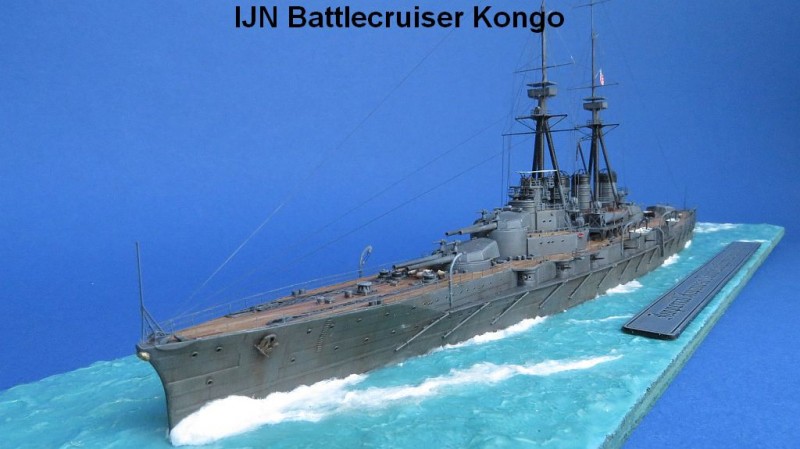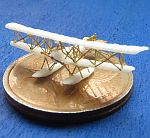You are viewing the archived version of the site.
Go to modelshipwrights.com for the current dynamic site!
Go to modelshipwrights.com for the current dynamic site!
1⁄700IJN Kongo 1914
...
Post a Comment
The Kongo was the flagship of the four Kongo battle cruisers. At the same time, it was the first Japanese naval battle cruiser and the last ship to be built outside Japan. The sister ships were all built in Japan. The order to built the Kongo was given 1910 in response to the first battle cruiser, the HMS Invincible. The four battle cruisers were part of the "eight-eight" fleet after eight battle cruisers and battleships were to be built to renew the Japanese fleet. These included the not completed Amagi battle cruisers, the Yamashiro and Ise half-sisters, the Nagato and the also not completed Tosa battleships.
With the arrival of the Kongo, it was the strongest ship in the Japanese fleet. For the first time, it had four double turrets with 356 mm (14 in) guns as main armament. The secondary armament consisted of sixteen 152 mm guns. In addition, there were eight 76 mm guns and four 6.5 mm machine guns. The Kongo was laid down in 1911 at the Vickers shipyard in Barrows-in-Furness and the launch was on May 18, 1912. The fitting out took place in Portsmouth. On August 16, 1913, the Kongo was completed and put into service. Shortly thereafter the journey back to Japan with a stop in Singapore took place. There she was checked at the Kure Naval Shipyard. With the outbreak of the First World War, the Kongo was sent to the Pacific for patroling. Japan claimed the German colony Tsingtau in China and the Kongo with their sister ship the Hiei secured the siege of Tsingtau. However, with the sinking of the German East Asia fleet there was no longer a need for it. And so the Kongo spent the rest of the war alternately patrolling the Pacific or at the shipyard.
The kit comes from the company Kajika and which is a branch of Flyhawk. The quality of the kit is correspondingly good. Although there are now most Japanese ships available from the time of the Second World War, older or as in this case with a previous construction state are lacking. So a big thanks to Kajika in making this kit The model did not make any problems during construction, just like other Flyhawk kits. For this I used Kajika's etching parts, the main and middle artillery brass barrels and the mask for masking the wooden decks. The mask fitted perfectly and spared painstaking masking. Rather a disappointment were the etching parts, these were unusually rough compared to those of Flyhawk. I did not use the ladders since the steps could not be fold. Also the railing was too long here and there and had to be shortened. Thus the railing had no opening for the ladder in front of the D turret. Also I would have wanted a few etching parts for the anchors and cutters. So I took some of Flyhawk and Fstar model. Also to mention is, that no torpedo net included. However, pictures from the time of the testing in England show that none was on board yet. So this is correct for a certain time.
I painted the model without big thoughts about the correct color with Tamiyas Sasebo gray. The details as well as the wooden deck I painted with Vallejo colors. The water was created as usual with the Water Effects of Vallejo. For the waves, I again put cotton wool into the water surface. I hope this has been done better thanks to the help of Rainer Vögle.
With the arrival of the Kongo, it was the strongest ship in the Japanese fleet. For the first time, it had four double turrets with 356 mm (14 in) guns as main armament. The secondary armament consisted of sixteen 152 mm guns. In addition, there were eight 76 mm guns and four 6.5 mm machine guns. The Kongo was laid down in 1911 at the Vickers shipyard in Barrows-in-Furness and the launch was on May 18, 1912. The fitting out took place in Portsmouth. On August 16, 1913, the Kongo was completed and put into service. Shortly thereafter the journey back to Japan with a stop in Singapore took place. There she was checked at the Kure Naval Shipyard. With the outbreak of the First World War, the Kongo was sent to the Pacific for patroling. Japan claimed the German colony Tsingtau in China and the Kongo with their sister ship the Hiei secured the siege of Tsingtau. However, with the sinking of the German East Asia fleet there was no longer a need for it. And so the Kongo spent the rest of the war alternately patrolling the Pacific or at the shipyard.
The kit comes from the company Kajika and which is a branch of Flyhawk. The quality of the kit is correspondingly good. Although there are now most Japanese ships available from the time of the Second World War, older or as in this case with a previous construction state are lacking. So a big thanks to Kajika in making this kit The model did not make any problems during construction, just like other Flyhawk kits. For this I used Kajika's etching parts, the main and middle artillery brass barrels and the mask for masking the wooden decks. The mask fitted perfectly and spared painstaking masking. Rather a disappointment were the etching parts, these were unusually rough compared to those of Flyhawk. I did not use the ladders since the steps could not be fold. Also the railing was too long here and there and had to be shortened. Thus the railing had no opening for the ladder in front of the D turret. Also I would have wanted a few etching parts for the anchors and cutters. So I took some of Flyhawk and Fstar model. Also to mention is, that no torpedo net included. However, pictures from the time of the testing in England show that none was on board yet. So this is correct for a certain time.
I painted the model without big thoughts about the correct color with Tamiyas Sasebo gray. The details as well as the wooden deck I painted with Vallejo colors. The water was created as usual with the Water Effects of Vallejo. For the waves, I again put cotton wool into the water surface. I hope this has been done better thanks to the help of Rainer Vögle.
Copyright ©2021 by Christian Hoeltge. _OPINIONS Model Shipwrights, KitMaker Network, or Silver Star Enterrpises. Images also by copyright holder unless otherwise noted. Opinions expressed are those of the author(s) and not necessarily those of Model Shipwrights. All rights reserved. Originally published on: 2017-06-20 15:42:15. Unique Reads: 7421






















